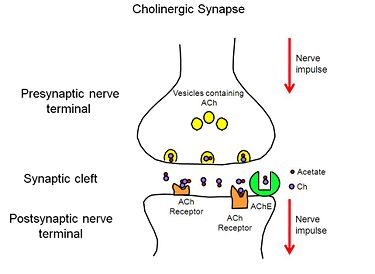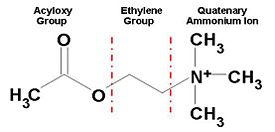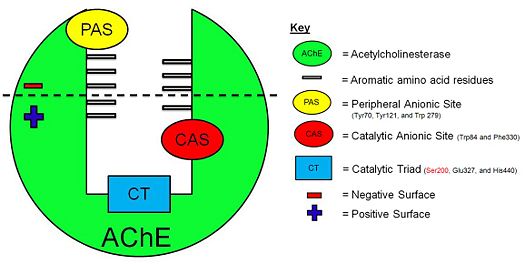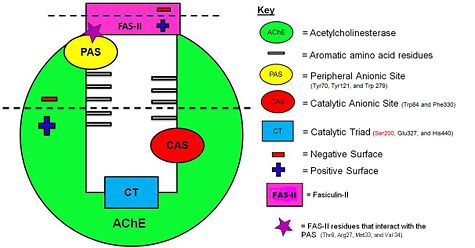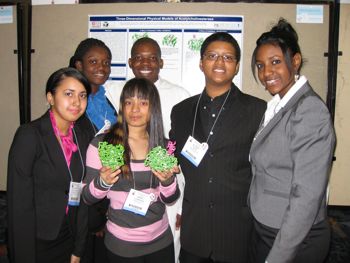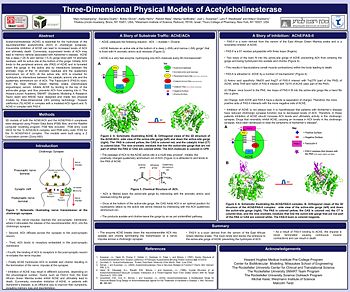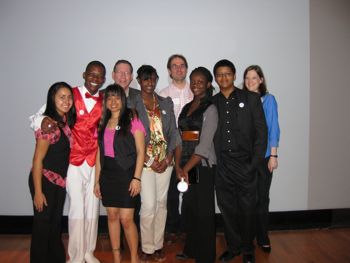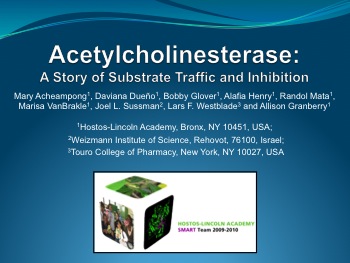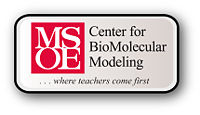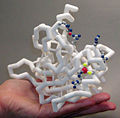Sandbox 988
From Proteopedia
(Difference between revisions)
| Line 1: | Line 1: | ||
| - | ==Your Heading Here (maybe something like 'Structure')==<StructureSection load='1dq8' size='500' side='right' caption='Structure of HMG-CoA reductase (PDB entry [[1dq8]])' scene=''> | + | ==Your Heading Here (maybe something like 'Structure')==<StructureSection load='1dq8' size='500' side='right' caption='Structure of HMG-CoA reductase (PDB entry [[1dq8]])' scene=''>==='''Introduction'''=== |
| - | + | ||
| - | + | ||
| - | + | ||
| - | + | ||
| - | + | ||
| - | + | ||
| - | + | ||
| - | + | ||
| - | + | ||
| - | + | ||
| - | + | ||
| - | + | ||
| - | ==='''Introduction'''=== | + | |
Acetylcholinesterase(AChE) is essential for the hydrolysis of the neurotransmitter acetylcholine(ACh), and therefore the termination of the nerve impulse in cholinergic synapses. Irreversible inhibition of AChE can lead to increased levels of ACh in cholinergic synapses and ultimately death. Conversely, suppressed levels of ACh may lead to memory deficits associated with Alzheimer's disease. AChE has a deep(20Å) and narrow(5Å) gorge lined with 14 aromatic residues, with its active site at the bottom of the gorge. Initially, ACh binds to the peripheral anionic site(PAS) of AChE and is funneled down the gorge to the active site by interactions between the aromatic rings of the 14 aromatic residues and the quaternary ammonium ion of ACh. At the active site, ACh is oriented for hydrolysis by interactions between the catalytic anionic ion site and the quaternary ammonium ion of ACh. The Fasciculin-II (FAS-II)toxin, a component of the East African Green Mamba snake(''Dendroaspis angusticeps'') venom, inhibits AChE by binding to the top of the active-site gorge, including residues that form the PAS; thus preventing ACh from entering the active-site gorge. The Hostos-Lincoln Academy Students Modeling A Research Topic(S.M.A.R.T) team and the Center for BioMolecular Modeling have designed and fabricated two physical models using a combination of computational molecular modeling and three-dimensional(3D) printing technology: ''Torpedo californica''(''Tc'') AChE in complex with a modeled ACh ligand and ''Tc''AChE in complex with FAS-II. | Acetylcholinesterase(AChE) is essential for the hydrolysis of the neurotransmitter acetylcholine(ACh), and therefore the termination of the nerve impulse in cholinergic synapses. Irreversible inhibition of AChE can lead to increased levels of ACh in cholinergic synapses and ultimately death. Conversely, suppressed levels of ACh may lead to memory deficits associated with Alzheimer's disease. AChE has a deep(20Å) and narrow(5Å) gorge lined with 14 aromatic residues, with its active site at the bottom of the gorge. Initially, ACh binds to the peripheral anionic site(PAS) of AChE and is funneled down the gorge to the active site by interactions between the aromatic rings of the 14 aromatic residues and the quaternary ammonium ion of ACh. At the active site, ACh is oriented for hydrolysis by interactions between the catalytic anionic ion site and the quaternary ammonium ion of ACh. The Fasciculin-II (FAS-II)toxin, a component of the East African Green Mamba snake(''Dendroaspis angusticeps'') venom, inhibits AChE by binding to the top of the active-site gorge, including residues that form the PAS; thus preventing ACh from entering the active-site gorge. The Hostos-Lincoln Academy Students Modeling A Research Topic(S.M.A.R.T) team and the Center for BioMolecular Modeling have designed and fabricated two physical models using a combination of computational molecular modeling and three-dimensional(3D) printing technology: ''Torpedo californica''(''Tc'') AChE in complex with a modeled ACh ligand and ''Tc''AChE in complex with FAS-II. | ||
| Line 240: | Line 227: | ||
<font color = 'red'>SMART Teams (S</font>tudents <font color = 'red'>M</font>odeling <font color = 'red'>A</font> <font color = 'red'>R</font>esearch <font color = 'red'>T</font>opic) is a science outreach program developed by the MSOE Center for BioMolecular Modeling. In this program, teams of high school students work with a local resarch lab to design and build a physical model of a protein that is being investigated by the lab. The goal of the SMART Team program is to introduce students to the real world of science --- as it exists in a local research lab. The development of this program was supported by grants from the NIH-NCRR SEPA program (Science Education Partnership Award) and an HHMI Precollege Science Education Award. For more information about this program, visit the [[Group:SMART:Teams|SMART Teams Proteopedia home page]] or visit the CBM web site at [http://www.rpc.msoe.edu/cbm www.rpc.msoe.edu/cbm]. | <font color = 'red'>SMART Teams (S</font>tudents <font color = 'red'>M</font>odeling <font color = 'red'>A</font> <font color = 'red'>R</font>esearch <font color = 'red'>T</font>opic) is a science outreach program developed by the MSOE Center for BioMolecular Modeling. In this program, teams of high school students work with a local resarch lab to design and build a physical model of a protein that is being investigated by the lab. The goal of the SMART Team program is to introduce students to the real world of science --- as it exists in a local research lab. The development of this program was supported by grants from the NIH-NCRR SEPA program (Science Education Partnership Award) and an HHMI Precollege Science Education Award. For more information about this program, visit the [[Group:SMART:Teams|SMART Teams Proteopedia home page]] or visit the CBM web site at [http://www.rpc.msoe.edu/cbm www.rpc.msoe.edu/cbm]. | ||
| + | .</StructureSection><!-- | ||
| + | Please use the "3D" button above this box to insert a Jmol applet (molecule) on this page. | ||
| + | Or use the four-green-boxes-button to insert scrollable text adjacent | ||
| + | to a Jmol applet. Check out the other buttons as well! | ||
| + | =='''Physical Models of Acetylcholinesterase in Complex with Acetylcholine and the Green Mamba Snake Toxin, Fasciculin-II'''== | ||
| + | Students: Mary Acheampong. Daviana Dueño, Bobby Glover, Alafia Henry, Randol Mata, and Marisa VanBrakle, Hostos-Lincoln Academy. | ||
| + | |||
| + | Teacher: Allison Granberry, Hostos-Lincoln Academy | ||
| + | |||
| + | Mentors: Joel Sussman, Weissman Institute of Science, and Lars Westblade, Touro College of Pharmacy. | ||
| + | ---- | ||
| + | ---- | ||
Revision as of 04:52, 31 July 2011
==Your Heading Here (maybe something like 'Structure')==
| |||||||||||

